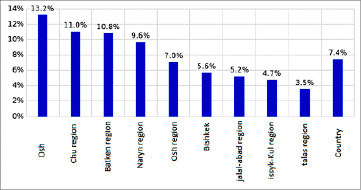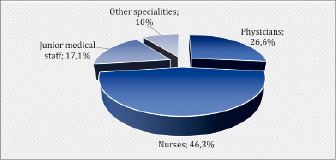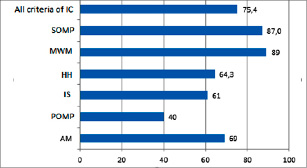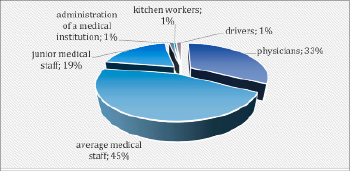Introduction
According to WHO data, from January 2020 to May 2021, according to the most conservative estimates, from СOVID-19 115 thousand doctors died. [1]
As of September 5, 44,316 cases of laboratory-confirmed coronavirus infection were registered in Kyrgyzstan, which is 681.7 cases per 100 thousand population. According to official statistics of the Ministry of Health of the Kyrgyz Republic, as of the beginning of September 2020, more than three thousand cases of COVID-19 were registered in the republic among medical workers, which is almost 20% of the incidence among the population. The highest rates were registered in Osh, Chui oblast, and Bishkek. In the city of Osh outbreaks of coronavirus infection were registered in the Osh Inter-regional Clinical Hospital (OIRCH), in The City Perinatal Center (CPC), in the children’s infectious diseases hospital of The Osh City Clinical Hospital [2, 3].
Materials and methods of research
The data of the Department of Disease Prevention and State Sanitary and Epidemiological Surveillance (DDPSSES) was analyzed from the beginning of the pandemic to 08.05.2020. Also, employees of the Republican scientific and practical Center for infection Control conducted an epidemiological study of COVID-19 outbreaks among employees in 9 hospitals (Bishkek, Osh, Jalalabad and Naryn regions). The implementation of infection control measures in these hospitals was evaluated during the epidemiological studies. Assessment sheets/tools were developed by the Republican Scientific and Practical Center for Infection Control staff to conduct an epidemiological survey [4-6]. Preliminary work was carried out to assess the Infection prevention and infection control in healthcare organizations, the availability of personal protective equipment for healthcare organizations, and other safety factors at the workplace of employees of healthcare organizations. Assessment sheets were tested in the epidemiological investigation of cases of nosocomial infection of medical workers and patients in multi-specialty hospitals in Bishkek, Osh, Jalal-Abad, Osh and Naryn regions (9 hospitals).
We also conducted a survey of 289 employees of healthcare organizations who had undergone COVID-19. Selection criteria for the survey are employees (medical and non-medical personnel) working in healthcare organizations of the Kyrgyz Republic who had laboratory-confirmed infection with SARS-CoV-2 coronavirus in the period from March 1, 2020 to June 1, 2020. Statistical data processing was carried out using a personal computer in the Microsoft Office Excel 2010 program.
Results of the research and discussions
A preliminary analysis of the epidemiological reports of the Ministry of Health of the Russian Federation on the probable factors that influenced the infection of medical workers with COVID-19 on 08.05.2020 was carried out. The first cases of COVID-19 in healthcare organizations were detected as a result of testing for: when employees have clinical manifestations of respiratory infection or pneumonia; if they have a history of contact with a confirmed case of COVID-19; after completing a 14-day shift in the red zone, and before completing the observation period after leaving the red zone.
According to the Department of Public Health, 88% of cases of infection of medical personnel are related to the provision of medical services to patients with COVID-19 (Table). A key risk factor is contact at work with colleagues (35%), which indicates that administrative infection control measures related to the organization of safety at the workplace were not implemented For example, the work was not organized in such a way that employees who provide services to patients with COVID-19 did not overlap with employees who provide services to the rest of the population. Also, one of the likely risk factors for infection for health workers was staying in observatories, after completing a 14-day shift, or after unprotected contact (without appropriate PPE) with a patient with a confirmed diagnosis of COVID-19. Medical workers were placed in observatories with negative results of PCR diagnostics, but on the 12-14 day of their stay in the observatories, 5 to 17 medical workers from one observator simultaneously received a positive PCR test. The organization of proper accommodation of employees in the observatory is also included in administrative measures [7].
If on the date of 08.05.2020 there were 223 cases of diseases among employees of medical institutions, then as of 09.08.2020 the number of ill health workers was 2948. Figure 1 shows an analysis of the incidence of health workers in the Kyrgyz Republic by region, the largest proportion of cases occurred in Osh, which is associated with an outbreak of nosocomial infections in the Osh City Perinatal Center (OCPC).
An analysis of the data provided by the DDPSSES showed that nurses are more at risk of contracting COVID-19, this is due to a variety of reasons, primarily due to the fact that nurses are in more frequent and close contact with patients and are exposed to more exposure (fig. 2).
The developed assessment tools made it possible to conduct an initial assessment of the risk factors for the occurrence of ISM and signs indicating an epidemic problem, as well as to conduct an epidemiological analysis of the collected data that is unified for all healthcare organizations of the Kyrgyz Republic.
Figure 3 shows an analysis of the infection safety system assessment by functional infection control blocks in hospitals where COVID-19 cases were detected among employees and patients for the period from April to June 2020.
The number of cases of COVID-19 among employees of health organizations by the nature of their services to the population as of 08.05.2020.
|
Probable conditions of contact with COVID-19 |
Number of cases |
% |
|
Infection is related to professional activities |
198 |
88% |
|
Contact at work with colleagues with COVID-19 |
79 |
35% |
|
Working in hospitals for COVID-19 |
40 |
18% |
|
Working in observatories for contact people |
34 |
15% |
|
Working in mobile teams |
27 |
12% |
|
Working in isolation centers for people with suspected COVID-19 |
4 |
2% |
|
Epidemiological investigation of COVID-19 cases |
4 |
2% |
|
Services for patients with COVID-19 in primary health care |
7 |
3% |
|
Other health services for people infected with COVID-19 |
3 |
1% |
|
The infection is not related to professional activity |
25 |
12% |
|
Family contacts with COVID-19 |
6 |
3% |
|
Sources not installed |
19 |
9% |
|
Total |
223 |
100% |

Fig. 1. Percentage of health workers infected with COVID-19 from the total number of cases by region (n=2948)

Fig. 2. Distribution of COVID-19 among medical personnel of institutions (n=2948)

Fig. 3. Results of the analysis according to the Infection prevention and infection control criteria (average % of execution)
Note: AM – Administrative measures; POMP protection of medical personnel, AM component; ICET – infection control education and training; HH – hospital hygiene; IS – isolation system; SOMP – safety of medical procedures; SONI – surveillance of nosocomial infections; CSD – centralized sterilization department; MWM – medical waste management
As can be seen in Figure 3, not a single hospital provided the implementation of infection control measures corresponding to the high-level assessment (76-100%). On average, all activities in the studied hospitals were performed by 75.4 %, which corresponds to average level of infection control implementation (51-75%) However, this does not ensure the infectious safety of patients and medical personnel in a pandemic. A high level of implementation (corresponding to 76-100%) is observed only in the criteria of infection control: safety of medical procedures (87%) and medical waste management (89%).
At the same time, measures to ensure individual protection of medical personnel were least implemented (40%), this component is included in the criteria “administrative support of the infection control program/administrative measures” (AM). The activities carried out in hospitals meet the basic level (26-50%), which is insufficient to protect patients and medical staff.
As part of the study, 289 medical professionals were interviewed. Among the surveyed patients, 88% were female, with the maximum value in Naryn region (90%) and the minimum value in Chui region (50%). The proportion of males in different regions varied from 50% to 10%. This distribution reflects the overall distribution of health workers in the Kyrgyz Republic by gender, where the nursing profession is traditionally considered “female”.
The average age of health workers in the entire sample was 45 years, the minimum age was 21 years, and the maximum age was 71 years. The median age was 47 years. More than half of the respondents (61%) are aged from 20 to 49 years. More than a quarter of respondents in the entire sample (30%) fall in the age group from 40 to 49 years, with the minimum value in Osh region (22%) and the maximum in Batken region (67%). The youngest group of patients is noted in the Chui region-with COVID-19, 100% were people under the age of 49 years. In the republic, almost 39% of ill health workers were over 50 years old, because in state health organizations, older employees predominate.
A little less than half of the respondents were average medical personnel (45%), doctors (33%) were the second largest number of sick employees of medical organizations, and junior medical personnel (nurses, distributors, laundresses, housewives, cooks, drivers, etc.) were slightly less than 22% (Figure 4). According to the eHealth Center, currently the number of nurses in the country is 2.5 times higher than the number of doctors. This sample reflects the situation with staffing in healthcare organizations, in addition, nurses are in closer contact with patients compared to other health workers and are at a higher risk of SARS-CoV-2 infection.
Of the 289 employees of medical institutions surveyed, 161 (56%) provided direct services to patients with a confirmed diagnosis/suspicion of COVID-19, among the remaining 128 health workers there are those who did not provide services to patients (engineer, procurement specialist, etc.), as well as those who work with patients with other diagnoses However, they may be potentially infected with SARS-Cov-2, without clinical manifestations.

Fig. 4. Distribution of employees of healthcare organizations diagnosed withCOVID-19 by specialty, (n=289)
Among the affected physicians, the majority were attracted to work in hospitals repurposed to provide services for the treatment of COVID-19 (41%), 30% of medical workers worked in observatories and mobile teams, and 13% – in sanitary quarantine point, family medicine center, and ambulance stations.
Conclusion
Health workers are at high risk of infection due to the fact that they are engaged in work with dangerous working conditions performed in special conditions associated with the risk of infection.
To ensure safe working conditions, the heads of healthcare organizations are required to implement administrative measures. As shown by the assessment of the implementation of the infection control criteria (Figure 3), the implementation of administrative measures was insufficient-only 69%. And the implementation of the component on individual protection of medical personnel, as noted above, was very low – 40%. Therefore, SOPs were developed (Order of the Ministry of Health of the Kyrgyz Republic dated 8 May 2020, No. 297 “On approval of temporary standard operating procedures for healthcare organizations of the Republic during the COVID-19 epidemic”), where they were prescribed three levels of protection for medical personnel, depending on the level of risk of infection. Administrative measures to ensure safety for health workers in the workplace are also indicated. The main administrative measures are those that should be provided by the management of healthcare organizations:
• Provide access to personal protective equipment (PPE) for health workers involved in all services;
• Ensure availability and control of PPE stocks;
• Monitor and control PPE supply requests;
• Control the distribution of PPE from the organization's warehouses;
• Appoint a trained person responsible for the provision and use of PPE;
• Provide facilities for performing a Fit test for tightness of the respirator (to select the right shape of the respirator that provides a tight fit);
• Organize practical trainings for medical staff on prevention, diagnosis and treatment COVID-19;
• Responsible for the development and approval of internal regulations on prevention, diagnosis and treatment COVID-19.
• Arrange places for medical staff to put on and remove PPE. If possible, it is recommended to provide a full-length mirror for putting on PPE (for monitoring the putting on of PPE by health workers).
• Organize the work of personnel involved in providing health services to people with clinical symptoms COVID-19 and / or with a laboratory-confirmed case, with the provision of a full set of PPE, with conditions for rest. Organize sorting and redirection of patients.

